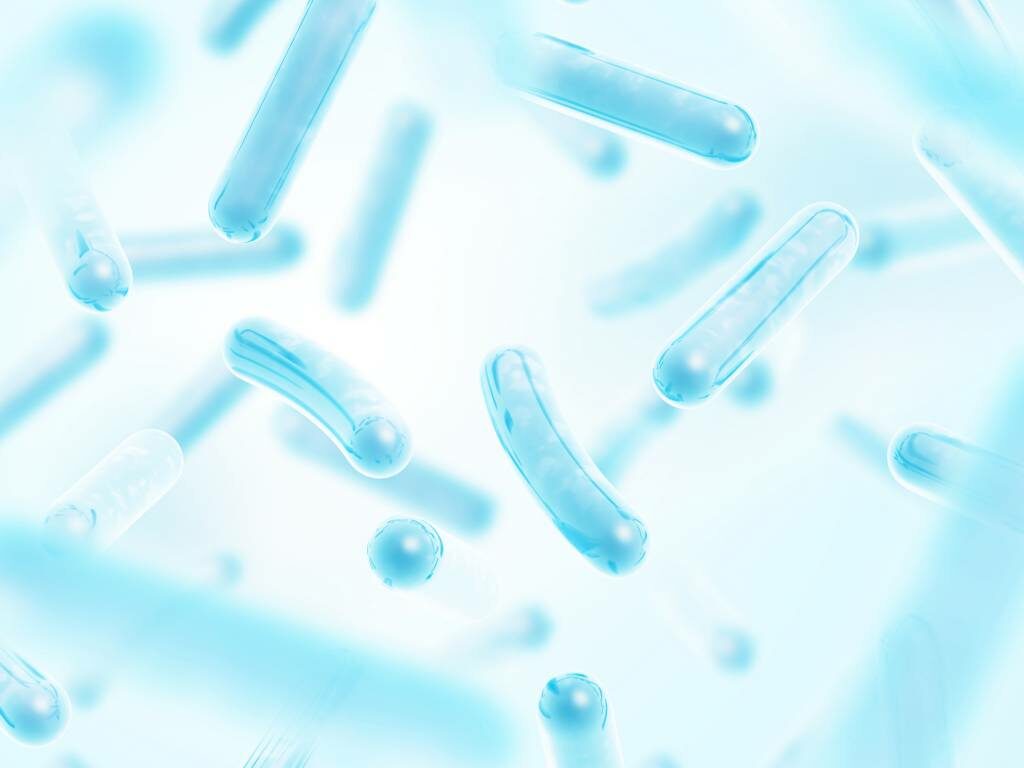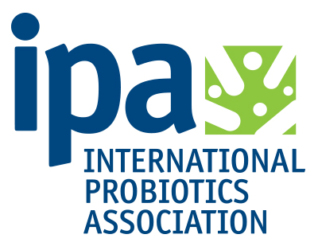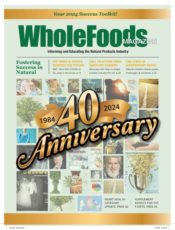
Quicklinks
WholeFoods Magazine
A Role for Probiotics in Reducing Kidney Stones?

Kidney stones —formed from minerals and salts—can be painful and costly to treat. Despite decades of research, treatment options are often invasive and evidence reveals a high rate of reoccurrence. Recently, the intestinal microbiome has become a focus for novel therapies using probiotics to lessen kidney stone formation.
While there are several types of kidney stones, about 70 to 80% are composed of calcium oxalate, created when calcium combines with oxalate in the urine.
Oxalate is a naturally occurring compound derived from metabolism in the liver and through certain plant foods in our diets. Unable to be metabolized, oxalate is absorbed through the intestines and combines with calcium in excreted urine to form stones. Strikingly, all the main nutritional imbalances associated with increased risk of calcium nephrolithiasis are also associated with specific alterations of gut microbiota composition.
Fortunately, some intestinal bacteria are able to degrade dietary oxalate, thereby opening a possible window of opportunity for use of probiotics to manipulate the intestinal microbiome in hopes of altering oxalate absorption, and associated development of kidney stones.
Moreover, in a 2020 systematic review of 25 studies, adults with kidney stones had a unique gut microbiota profile compared to controls: Bacteroides were consistently reported to be in increased abundance while Dorea, Enterobacter, Christensenellaceae, and its genus Christensenellaceae R7 group, decreased in adults with kidney stones.
Many studies support the concept that gut microbiota dysbiosis is present in stone formers, suggesting that cross talk between the gut and the kidney may be involved in the pathophysiology of calcium oxalate stones.
O. formigenes colonization rates vary in adult populations. Inflammatory bowel disease, recurrent nephrolithiasis, morbid obesity, and cystic fibrosis are associated with calcium oxalate stones and show low colonization rates.
In a large cross sectional study, only 17% of 247 stone subjects were colonized with O. formigenes, compared to 38% of 259 controls. Studies show that O. formigenes colonization in fecal samples was lower in stone formers than stone-free controls.
In support, multiple epidemiological studies suggest a protective role for O. formigenes. A strong inverse association between its colonization and recurrent calcium oxalate renal stones was seen in human studies.
In a study of South African men, lactobacilli species with high oxalate degrading capacity have been identified and were associated with a lower prevalence of calcium oxalate kidney stones.
The results were conflicting. Some studies showed reductions in urinary oxalate excretion after probiotic treatment and others showed no changes from a starting point. What's more, the clinical significance of such reductions was unclear, since oxalate excretion is only one of many elements leading to risk of kidney stones.
Many of the nutritional imbalances seen in stone formers can also affect the gut microbiota composition. The microbiota may act as a metabolic modulator at the crossroad between nutrition and kidney function.
Future research may determine if manipulation with probiotics can decrease the risk of kidney stones.
Hatch, Marguerite. “Gut microbiota and oxalate homeostasis.” Annals of translational Medicine vol. 5,2 (2017): 36. doi:10.21037/atm.2016.12.70
Kaufman, David W et al. “Oxalobacter formigenes may reduce the risk of calcium oxalate kidney stones.” Journal of the American Society of Nephrology : JASN vol. 19,6 (2008): 1197-203. doi:10.1681/ASN.2007101058
Khan, Saeed R et al. “Kidney stones.” Nature reviews. Disease primers vol. 2 16008. 25 Feb. 2016, doi:10.1038/nrdp.2016.8
Klimesova, Klara et al. “Bifidobacterium animalis subsp. lactis decreases urinary oxalate excretion in a mouse model of primary hyperoxaluria.” Urolithiasis vol. 43,2 (2015): 107-17. doi:10.1007/s00240-014-0728-2
Lieske, John C. “Probiotics for prevention of urinary stones.” Annals of translational medicine vol. 5,2 (2017): 29. doi:10.21037/atm.2016.11.86
Magwira, C A et al. “Diversity of faecal oxalate-degrading bacteria in black and white South African study groups: insights into understanding the rarity of urolithiasis in the black group.” Journal of applied microbiology vol. 113,2 (2012): 418-28. doi:10.1111/j.1365-2672.2012.05346.x
Mehta, Mansi et al. “The role of the microbiome in kidney stone formation.” International journal of surgery (London, England) vol. 36,Pt D (2016): 607-612. doi:10.1016/j.ijsu.2016.11.024
Stanford, Jordan et al. “The gut microbiota profile of adults with kidney disease and kidney stones: a systematic review of the literature.” BMC nephrology vol. 21,1 215. 5 Jun. 2020, doi:10.1186/s12882-020-01805-w
Stern, Joshua M et al. “Evidence for a distinct gut microbiome in kidney stone formers compared to non-stone formers.” Urolithiasis vol. 44,5 (2016): 399-407. doi:10.1007/s00240-016-0882-9
Ticinesi, Andrea et al. “Calcium Oxalate Nephrolithiasis and Gut Microbiota: Not just a Gut-Kidney Axis. A Nutritional Perspective.” Nutrients vol. 12,2 548. 20 Feb. 2020, doi:10.3390/nu12020548
Turroni, S et al. “Oxalate consumption by lactobacilli: evaluation of oxalyl-CoA decarboxylase and formyl-CoA transferase activity in Lactobacillus acidophilus.” Journal of applied microbiology vol. 103,5 (2007): 1600-9. doi:10.1111/j.1365-2672.2007.03388.x
Zhang, Daling et al. “Urinary stone composition analysis and clinical characterization of 1520 patients in central China.” Scientific reports vol. 11,1 6467. 19 Mar. 2021, doi:10.1038/s41598-021-85723-3
Clare Fleishman, MS, RDN, bridges the gap between science and health across most platforms: major newspapers, magazines, books (Globesity), workshops, social media and websites. From corporate whiteboards to refugee schools in Egypt, Fleishman agitates for personal and public change. In 2010, she launched www.ProbioticsNow.com to share the cascade of new discovery in the microbiome. Always amazed at this “forgotten organ” Fleishman also creates white papers, blogs, videos and social media for the International Probiotics Association.
Kidney stones, in brief
Numerous risk factors are implicated in this condition, clinically referred to as nephrolithiasis: genetics, dehydration, a diet high in protein, salt or sugar, obesity, digestive diseases and other medical conditions as well as digestive surgeries. The lifetime risk of kidney stones is about 19% in men and 9% in women.While there are several types of kidney stones, about 70 to 80% are composed of calcium oxalate, created when calcium combines with oxalate in the urine.
Oxalate is a naturally occurring compound derived from metabolism in the liver and through certain plant foods in our diets. Unable to be metabolized, oxalate is absorbed through the intestines and combines with calcium in excreted urine to form stones. Strikingly, all the main nutritional imbalances associated with increased risk of calcium nephrolithiasis are also associated with specific alterations of gut microbiota composition.
Fortunately, some intestinal bacteria are able to degrade dietary oxalate, thereby opening a possible window of opportunity for use of probiotics to manipulate the intestinal microbiome in hopes of altering oxalate absorption, and associated development of kidney stones.
Microbiota and kidney stones
A recent study identified distinct differences in the gut microbiome of kidney stone patients compared to patients without stones. The Bacteroides genus was most abundant in the kidney stone group while Prevotella genus was most abundant in the control group.Moreover, in a 2020 systematic review of 25 studies, adults with kidney stones had a unique gut microbiota profile compared to controls: Bacteroides were consistently reported to be in increased abundance while Dorea, Enterobacter, Christensenellaceae, and its genus Christensenellaceae R7 group, decreased in adults with kidney stones.
Many studies support the concept that gut microbiota dysbiosis is present in stone formers, suggesting that cross talk between the gut and the kidney may be involved in the pathophysiology of calcium oxalate stones.
Oxalobacter formigenes
One organism stands out for its phenomenal oxalate-degrading ability: Oxalobacter formigenes (O. formigenes). For example, under controlled conditions, O. formigenes degraded up to 98% of available oxalate in vitro and also promoted endogenous oxalate secretion by the gut mucosa in mice.O. formigenes colonization rates vary in adult populations. Inflammatory bowel disease, recurrent nephrolithiasis, morbid obesity, and cystic fibrosis are associated with calcium oxalate stones and show low colonization rates.
In a large cross sectional study, only 17% of 247 stone subjects were colonized with O. formigenes, compared to 38% of 259 controls. Studies show that O. formigenes colonization in fecal samples was lower in stone formers than stone-free controls.
In support, multiple epidemiological studies suggest a protective role for O. formigenes. A strong inverse association between its colonization and recurrent calcium oxalate renal stones was seen in human studies.
Additional oxalate degraders
Other bacterial species also have key oxalate degrading genes and exhibit oxalate-degrading activity in vitro. Of 60 strains tested from 12 different species of lactobacilli, strains of L. acidophilus and L. gasseri were most efficient in their ability to degrade oxalate in vitro. In a mouse model, Bifidobacterium animalis subsp.lactis colonization decreased urinary oxalate by degrading dietary oxalate and reducing its intestinal absorption.In a study of South African men, lactobacilli species with high oxalate degrading capacity have been identified and were associated with a lower prevalence of calcium oxalate kidney stones.
Probiotics and kidney stones
Based on the alterations in gut microbiota with kidney stones, several studies have explored whether the administration of O. formigenes or other probiotic preparations with oxalate-degrading abilities could result in the reduction of kidney stone risk.The results were conflicting. Some studies showed reductions in urinary oxalate excretion after probiotic treatment and others showed no changes from a starting point. What's more, the clinical significance of such reductions was unclear, since oxalate excretion is only one of many elements leading to risk of kidney stones.
Diet and kidney stones
Calcium oxalate stone formers are often advised to reduce oxalate intake in their diets (nuts, spinach, peanuts, and wheat bran among others). However, such reductions can increase urinary oxalate excretion and stone risk if it is not associated with other dietary measures. Reducing sodium, animal protein and getting adequate calcium (counterintuitively) are also recommended.Many of the nutritional imbalances seen in stone formers can also affect the gut microbiota composition. The microbiota may act as a metabolic modulator at the crossroad between nutrition and kidney function.
Takeaway
The gut microbiome plays a role in modifying kidney stone risk by hosting bacteria capable of degrading oxalate, a component of the most prevalent stone. But a healthy gut microbiota also likely is involved in other key functions modulating risk of forming kidney stones. Notably, the main nutritional imbalances associated with increased risk—poor hydration, high salt, high animal protein intake, and reduced fruit and vegetable intake—are also linked with specific alterations of gut microbiota composition.Future research may determine if manipulation with probiotics can decrease the risk of kidney stones.
Key references
Abratt, Valerie R, and Sharon J Reid. “Oxalate-degrading bacteria of the human gut as probiotics in the management of kidney stone disease.” Advances in applied microbiology vol. 72 (2010): 63-87. doi:10.1016/S0065-2164(10)72003-7Hatch, Marguerite. “Gut microbiota and oxalate homeostasis.” Annals of translational Medicine vol. 5,2 (2017): 36. doi:10.21037/atm.2016.12.70
Kaufman, David W et al. “Oxalobacter formigenes may reduce the risk of calcium oxalate kidney stones.” Journal of the American Society of Nephrology : JASN vol. 19,6 (2008): 1197-203. doi:10.1681/ASN.2007101058
Khan, Saeed R et al. “Kidney stones.” Nature reviews. Disease primers vol. 2 16008. 25 Feb. 2016, doi:10.1038/nrdp.2016.8
Klimesova, Klara et al. “Bifidobacterium animalis subsp. lactis decreases urinary oxalate excretion in a mouse model of primary hyperoxaluria.” Urolithiasis vol. 43,2 (2015): 107-17. doi:10.1007/s00240-014-0728-2
Lieske, John C. “Probiotics for prevention of urinary stones.” Annals of translational medicine vol. 5,2 (2017): 29. doi:10.21037/atm.2016.11.86
Magwira, C A et al. “Diversity of faecal oxalate-degrading bacteria in black and white South African study groups: insights into understanding the rarity of urolithiasis in the black group.” Journal of applied microbiology vol. 113,2 (2012): 418-28. doi:10.1111/j.1365-2672.2012.05346.x
Mehta, Mansi et al. “The role of the microbiome in kidney stone formation.” International journal of surgery (London, England) vol. 36,Pt D (2016): 607-612. doi:10.1016/j.ijsu.2016.11.024
Stanford, Jordan et al. “The gut microbiota profile of adults with kidney disease and kidney stones: a systematic review of the literature.” BMC nephrology vol. 21,1 215. 5 Jun. 2020, doi:10.1186/s12882-020-01805-w
Stern, Joshua M et al. “Evidence for a distinct gut microbiome in kidney stone formers compared to non-stone formers.” Urolithiasis vol. 44,5 (2016): 399-407. doi:10.1007/s00240-016-0882-9
Ticinesi, Andrea et al. “Calcium Oxalate Nephrolithiasis and Gut Microbiota: Not just a Gut-Kidney Axis. A Nutritional Perspective.” Nutrients vol. 12,2 548. 20 Feb. 2020, doi:10.3390/nu12020548
Turroni, S et al. “Oxalate consumption by lactobacilli: evaluation of oxalyl-CoA decarboxylase and formyl-CoA transferase activity in Lactobacillus acidophilus.” Journal of applied microbiology vol. 103,5 (2007): 1600-9. doi:10.1111/j.1365-2672.2007.03388.x
Zhang, Daling et al. “Urinary stone composition analysis and clinical characterization of 1520 patients in central China.” Scientific reports vol. 11,1 6467. 19 Mar. 2021, doi:10.1038/s41598-021-85723-3
Clare Fleishman, MS, RDN, bridges the gap between science and health across most platforms: major newspapers, magazines, books (Globesity), workshops, social media and websites. From corporate whiteboards to refugee schools in Egypt, Fleishman agitates for personal and public change. In 2010, she launched www.ProbioticsNow.com to share the cascade of new discovery in the microbiome. Always amazed at this “forgotten organ” Fleishman also creates white papers, blogs, videos and social media for the International Probiotics Association.








